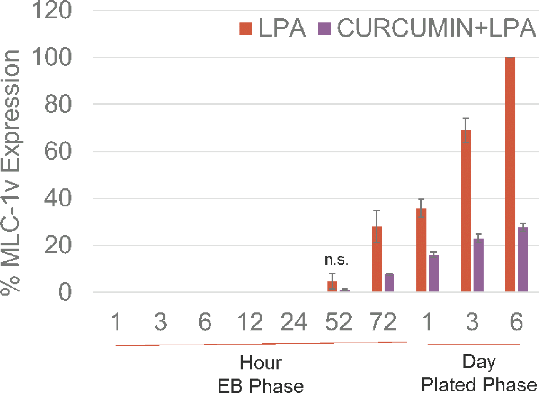Print version
Search Pub Med
| 177P London, UK Pharmacology 2017 |
Regulation of GATA4 expression by Curcumin, inhibiting LPA induced stem cell differentiation
Introduction: Stem cells have been widely considered as a potential therapy for the infarcted or failing myocardium. Indeed, the field still faces several challenges including identifying endogenous molecules and having a clear understanding of the cellular processes regulating differentiation. In this regard, we have embarked on a research program looking for endogenous biomolecules that regulate stem cell differentiation into cardiomyocytes and establishing the underlying molecular mechanisms. We report that the endogenous bio-lipid lysophosphatidic acid (LPA) can direct P19 stem cells down a cardiac lineage and does so through activation of GATA4 in a manner that is sensitive to Curcumin inhibition.
Method: P19 cells were maintained in α-Minimal Essential Medium supplemented with 10% foetal bovine serum and 1% penicillin-streptomycin at 37â—¦C with 5% CO2. Differentiation was initiated by growing the cells in Petri dishes to form embryoid bodies (EBs) in the presence of LPA (1-25 μM). When used, Curcumin was added to cells 30m prior to LPA treatment (1). The EBs were subsequently transferred into 6 well plates and cultured in a monolayer for 6 days. Lysates generated and subjected to western blotting for the expression of cardiac-specific myosin light chain-1v (MLC-1v) or phosphoGATA4. Statistical significance was evaluated with an unpaired Student\'s t-test for comparison between two groups or with ANOVA for comparison and contrast between multiple groups.
Results: Incubation of cells with LPA often resulted in beating clusters within monolayers which were indicative of cardiac-specific cells. Western blots for MLC-1v confirmed the successful differentiation of the stem cells into cardiomyocytes. LPA induced GATA4 in a time-dependent manner as early as 6hr following treatment (p=0.01). PhosphoGATA4 expression reached the peak at day3 and sustained throughout the culture period. Significant MLC-1v expression appeared after 72hr of EB formation (p=0.01), reaching peak 6 days after plating. More importantly, non-cytotoxic concentration of curcumin inhibited MLC-1v expression by 74.3±5.7% (p<0.01). In continuous culture, both GATA4 and MLC-1v reappeared after 72hr and increased over 6 days, but this never reached the levels observed in the absence of Curcumin.

Conclusions: The current findings demonstrate that LPA induces stem cell differentiation into cardiomyocytes with changes in MLC-1v expression showing significant correlation with changes in GATA4 expression (r=0.88). Importantly, LPA-induced differentiation inhibited by Curcumin, suppress lineage commitment through suppression of GATA4.
References:
1. Yilbas AE et al. (2014). Fr in Chem 2: 1-8.

